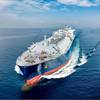Qatar Gas Transport Company (Nakilat) and Qatargas-II have signed 25-year timecharter deals to build the world’s largest liquefied natural gas carriers at a cost of $2.5bn.
Nakilat also has concluded shipbuilding contracts for the six QMax carriers with Daewoo Shipbuilding and Marine Engineering and Samsung Heavy Industries. They will build three QMax tankers each.
QMax carriers are of approximately 265,000cu m, the largest ever LNG tankers so far. However, they will be slightly smaller than the VLCCs (very large crude carriers) that currently transport crude oil around the world.
Addressing a press conference after the signing ceremony Nakilat vice-chairman, Faisal M al-Suwaidi, also Qatargas vice-chairman and chief executive officer, said the carriers, wholly owned by Nakilat, would be used to ferry LNG to consumers in Europe and the US.
Qatargas-II comprises Train 4 and 5, each with a production capacity of 7.8mn tons a year. Train 4 is scheduled to start production in 2008 and Train 5 in 2009. Al-Suwaidi said Qatargas-II had placed orders for eight QFlex LNG carriers almost a year ago. A QFlex tanker has a capacity of 215,000cu m.
By 2010 Nakilat would have equity in some 34 LNG carriers including both Q-Max and Q-Flex. Equity in 28 LNG tankers has already been picked up.
The equity level in these ships differs. Nakilat has 30% equity in some vessels. In others, the level ranges between 40% and 60%.
The double hull QMax ships have been designed with several state-of-the-art safety features. They include primary and secondary membrane barriers for LNG containment, twin screws and rudders for increased redundancy and improved maneuverability.
QMax also has enhanced firefighting system whereby the carbon dioxide system has been replaced by safer, cleaner firefighting agents. The accommodation area has been designed with a view to enhancing crew security in compliance with the stipulations of the International Maritime Organisation.
The QMax vessels will be powered by twin, slow speed diesel engines and will have fully redundant onboard re-liquefaction plants, which maximise LNG deliveries to customers. Al-Suwaidi said the adaptation of the shore-based technology allowed the carriers to use more efficient slow-speed diesel propulsion, a departure from the traditional but less efficient steam turbine.
It will result in a 40% reduction in overall emissions compared to traditional steam turbine vessels. Other environmental design enhancements include the application of toxin-free, silicon-based antifouling coatings and no oil or waste contaminated tanks adjacent to the outer hull.
Source: Doha Times
Featured videos

Inmarsat Enhances Service to Drive Digitalization

Tracking Foreign Vessels Working in the U.S. Jones Act Market

Inside the Electrified Truckable Tug
Subscribe for
Maritime Reporter E-News
Maritime Reporter E-News is the maritime industry's largest circulation and most authoritative ENews Service, delivered to your Email five times per week









